2009 CHRYSLER TOWN AND COUNTRY check engine
[x] Cancel search: check enginePage 463 of 543
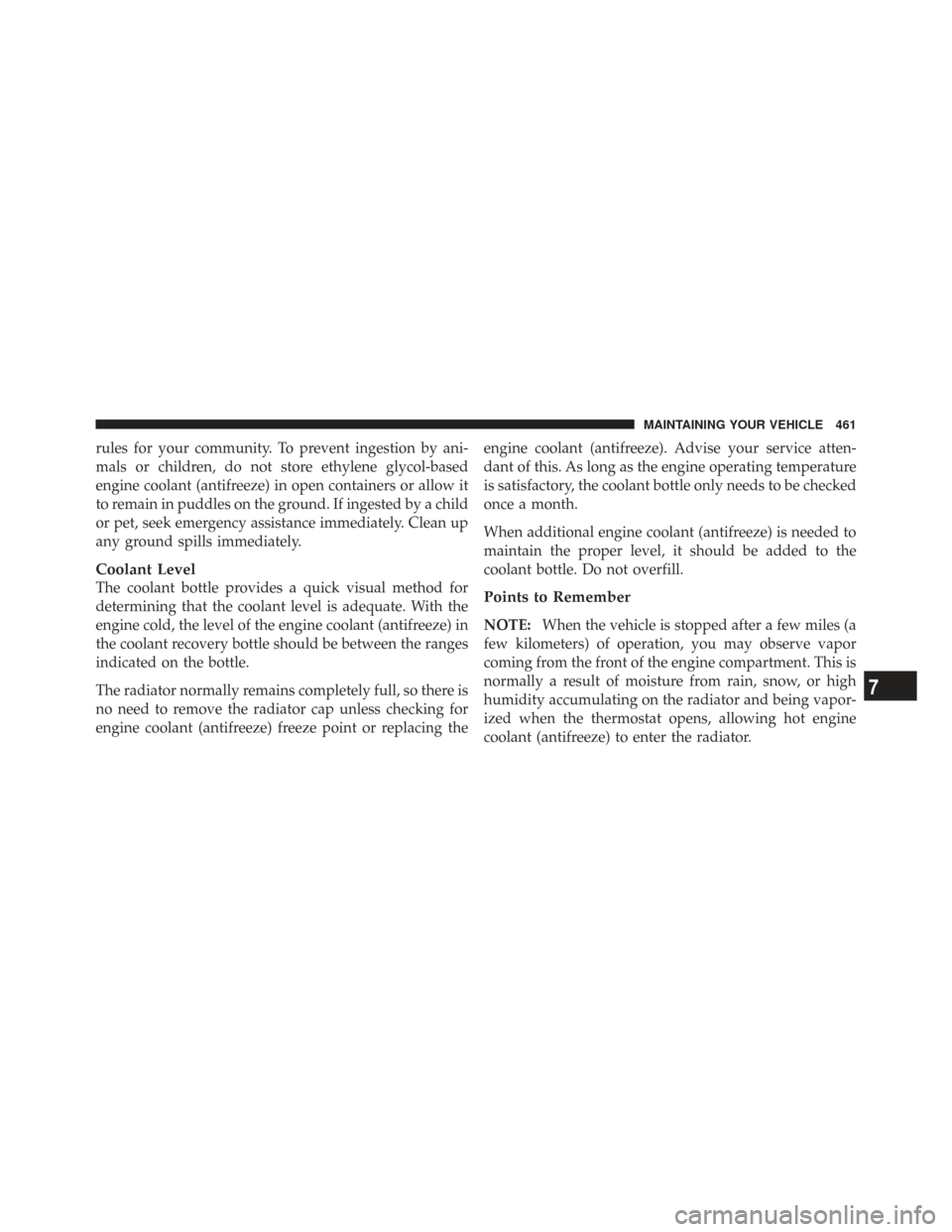
rules for your community. To prevent ingestion by ani-
mals or children, do not store ethylene glycol-based
engine coolant (antifreeze) in open containers or allow it
to remain in puddles on the ground. If ingested by a child
or pet, seek emergency assistance immediately. Clean up
any ground spills immediately.
Coolant Level
The coolant bottle provides a quick visual method for
determining that the coolant level is adequate. With the
engine cold, the level of the engine coolant (antifreeze) in
the coolant recovery bottle should be between the ranges
indicated on the bottle.
The radiator normally remains completely full, so there is
no need to remove the radiator cap unless checking for
engine coolant (antifreeze) freeze point or replacing theengine coolant (antifreeze). Advise your service atten-
dant of this. As long as the engine operating temperature
is satisfactory, the coolant bottle only needs to be checked
once a month.
When additional engine coolant (antifreeze) is needed to
maintain the proper level, it should be added to the
coolant bottle. Do not overfill.Points to Remember
NOTE:
When the vehicle is stopped after a few miles (a
few kilometers) of operation, you may observe vapor
coming from the front of the engine compartment. This is
normally a result of moisture from rain, snow, or high
humidity accumulating on the radiator and being vapor-
ized when the thermostat opens, allowing hot engine
coolant (antifreeze) to enter the radiator.
7
MAINTAINING YOUR VEHICLE 461
Page 464 of 543
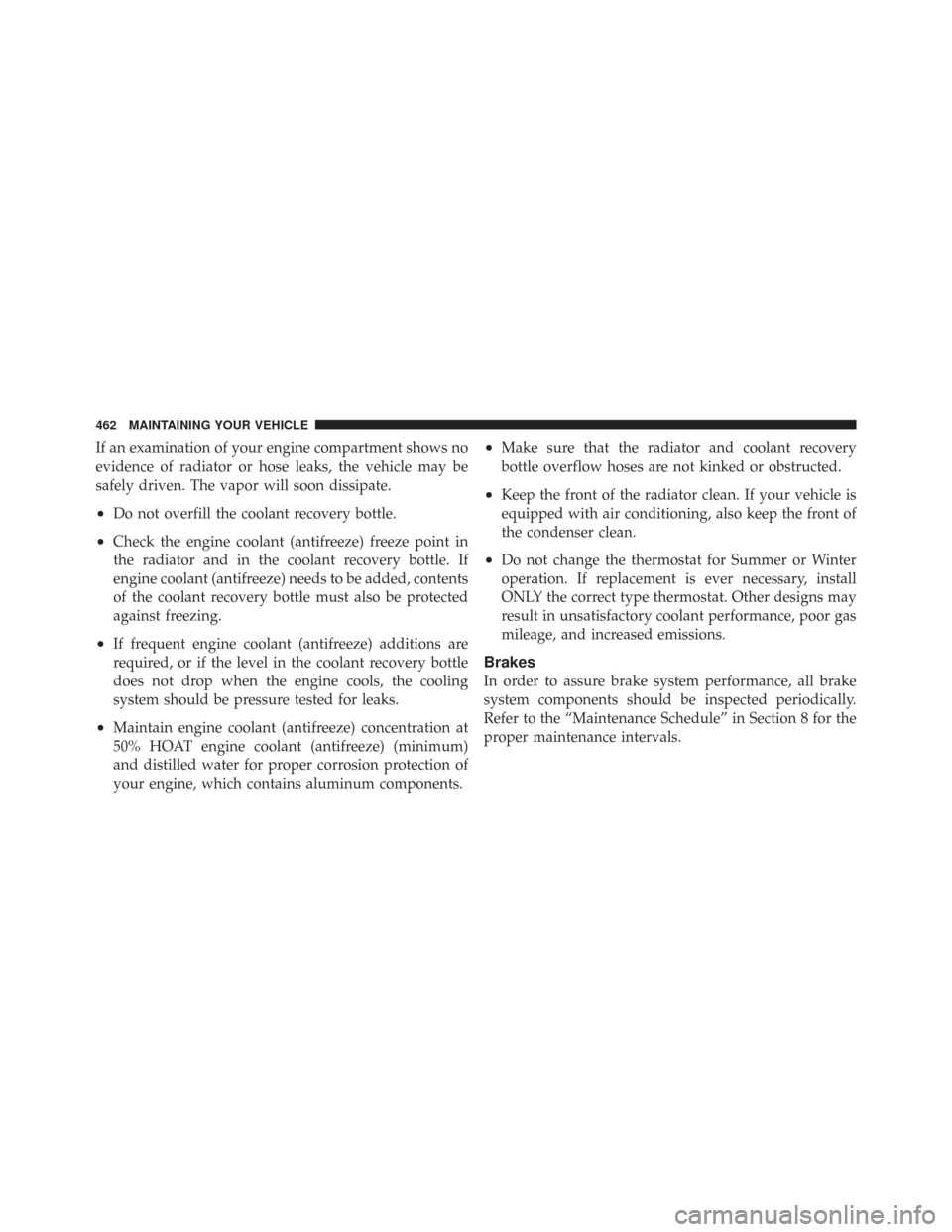
If an examination of your engine compartment shows no
evidence of radiator or hose leaks, the vehicle may be
safely driven. The vapor will soon dissipate.
•Do not overfill the coolant recovery bottle.
•Check the engine coolant (antifreeze) freeze point in
the radiator and in the coolant recovery bottle. If
engine coolant (antifreeze) needs to be added, contents
of the coolant recovery bottle must also be protected
against freezing.
•If frequent engine coolant (antifreeze) additions are
required, or if the level in the coolant recovery bottle
does not drop when the engine cools, the cooling
system should be pressure tested for leaks.
•Maintain engine coolant (antifreeze) concentration at
50% HOAT engine coolant (antifreeze) (minimum)
and distilled water for proper corrosion protection of
your engine, which contains aluminum components.
•Make sure that the radiator and coolant recovery
bottle overflow hoses are not kinked or obstructed.
•Keep the front of the radiator clean. If your vehicle is
equipped with air conditioning, also keep the front of
the condenser clean.
•Do not change the thermostat for Summer or Winter
operation. If replacement is ever necessary, install
ONLY the correct type thermostat. Other designs may
result in unsatisfactory coolant performance, poor gas
mileage, and increased emissions.
Brakes
In order to assure brake system performance, all brake
system components should be inspected periodically.
Refer to the “Maintenance Schedule” in Section 8 for the
proper maintenance intervals.
462 MAINTAINING YOUR VEHICLE
Page 468 of 543
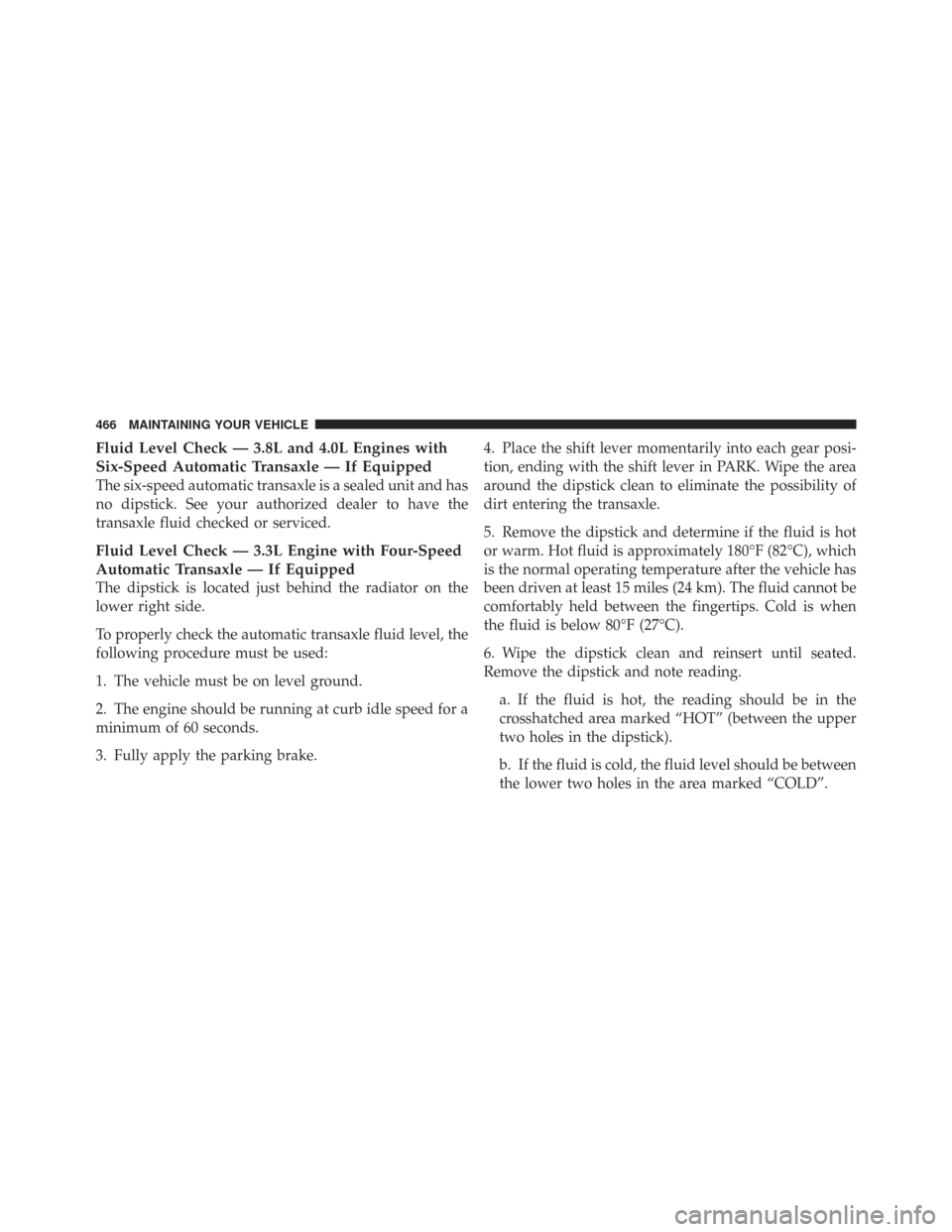
Fluid Level Check — 3.8L and 4.0L Engines with
Six-Speed Automatic Transaxle — If Equipped
The six-speed automatic transaxle is a sealed unit and has
no dipstick. See your authorized dealer to have the
transaxle fluid checked or serviced.
Fluid Level Check — 3.3L Engine with Four-Speed
Automatic Transaxle — If Equipped
The dipstick is located just behind the radiator on the
lower right side.
To properly check the automatic transaxle fluid level, the
following procedure must be used:
1. The vehicle must be on level ground.
2. The engine should be running at curb idle speed for a
minimum of 60 seconds.
3. Fully apply the parking brake.4. Place the shift lever momentarily into each gear posi-
tion, ending with the shift lever in PARK. Wipe the area
around the dipstick clean to eliminate the possibility of
dirt entering the transaxle.
5. Remove the dipstick and determine if the fluid is hot
or warm. Hot fluid is approximately 180°F (82°C), which
is the normal operating temperature after the vehicle has
been driven at least 15 miles (24 km). The fluid cannot be
comfortably held between the fingertips. Cold is when
the fluid is below 80°F (27°C).
6. Wipe the dipstick clean and reinsert until seated.
Remove the dipstick and note reading.
a. If the fluid is hot, the reading should be in the
crosshatched area marked “HOT” (between the upper
two holes in the dipstick).
b. If the fluid is cold, the fluid level should be between
the lower two holes in the area marked “COLD”.
466 MAINTAINING YOUR VEHICLE
Page 469 of 543
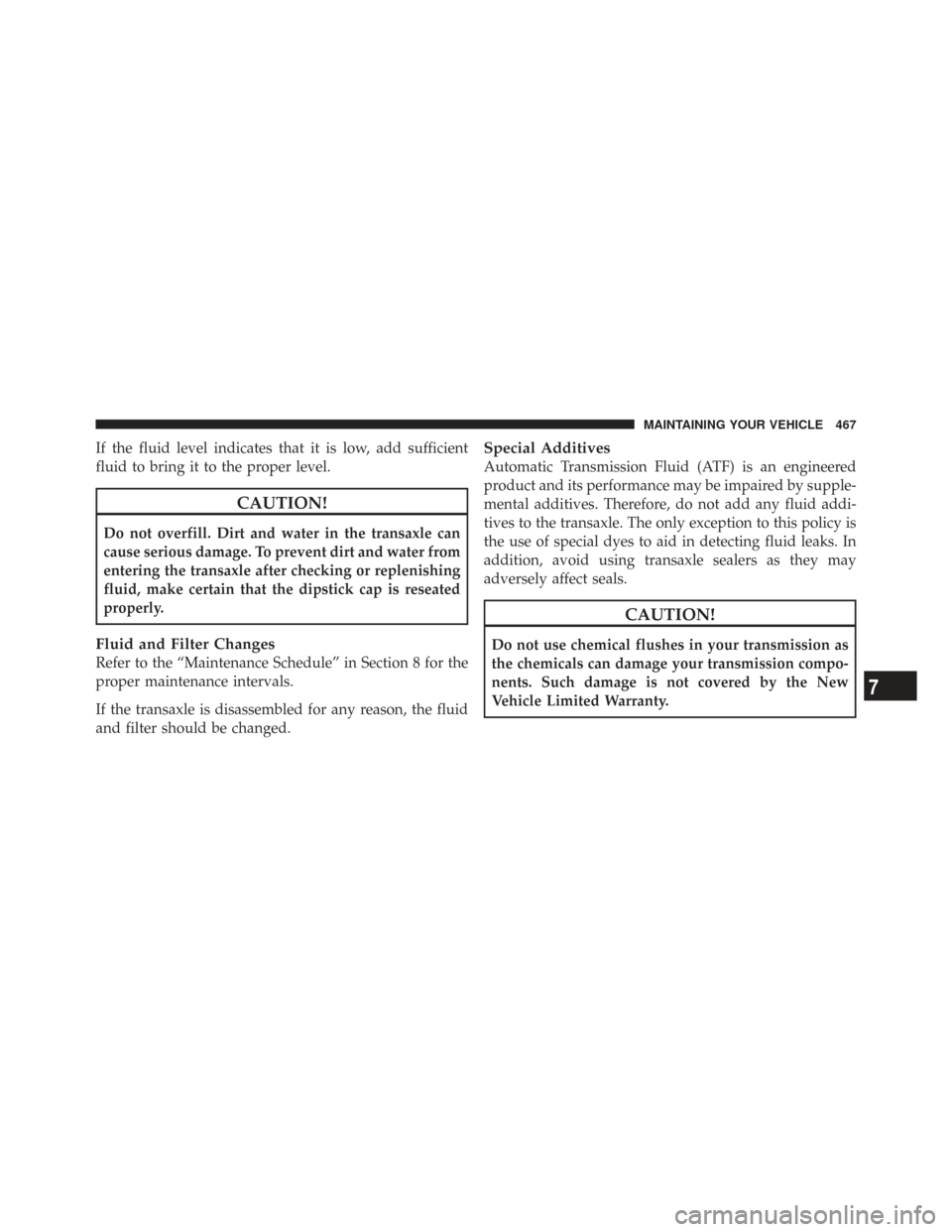
If the fluid level indicates that it is low, add sufficient
fluid to bring it to the proper level.
CAUTION!
Do not overfill. Dirt and water in the transaxle can
cause serious damage. To prevent dirt and water from
entering the transaxle after checking or replenishing
fluid, make certain that the dipstick cap is reseated
properly.
Fluid and Filter Changes
Refer to the “Maintenance Schedule” in Section 8 for the
proper maintenance intervals.
If the transaxle is disassembled for any reason, the fluid
and filter should be changed.
Special Additives
Automatic Transmission Fluid (ATF) is an engineered
product and its performance may be impaired by supple-
mental additives. Therefore, do not add any fluid addi-
tives to the transaxle. The only exception to this policy is
the use of special dyes to aid in detecting fluid leaks. In
addition, avoid using transaxle sealers as they may
adversely affect seals.
CAUTION!
Do not use chemical flushes in your transmission as
the chemicals can damage your transmission compo-
nents. Such damage is not covered by the New
Vehicle Limited Warranty.
7
MAINTAINING YOUR VEHICLE 467
Page 495 of 543

NOTE:
•The oil change indicator message will not monitor the
time since the last oil change. Change your vehicle’s
oil if it has been six months since your last oil change,
even if the oil change indicator message is NOT
illuminated.
•Change your engine oil more often if you drive your
vehicle off-road for an extended period of time.
•Under no circumstances should oil change intervals
exceed 6,000 miles (10 000 km) or six months, which-
ever comes first.
Your authorized dealer will reset the oil change indicator
message after completing the scheduled oil change. If this
scheduled oil change is performed by someone other
than your dealer, the message can be reset by referring to
the steps described under “Oil Change Required” in “Use
Factory Settings” of the EVIC section in this manual or under “Odometer/Trip Odometer” in the “Instrument
Cluster Descriptions section of this manual.
At Each Stop For Fuel
•Check the engine oil level about five minutes after a
fully warmed engine is shut OFF. Checking the oil
level while the vehicle is on level ground will improve
the accuracy of the oil level reading. Add oil only
when the level is at or below the ADD, SAFE or MIN
mark.
•Check the windshield washer solvent and add if
required.
Once A Month
•Check tire pressure and look for unusual wear or
damage.
•Inspect the battery and clean and tighten the terminals
as required.
8
M A I
N T
E
N A
N CE
S
C
H E
D
U L
E
SMAINTENANCE SCHEDULES 493
Page 496 of 543
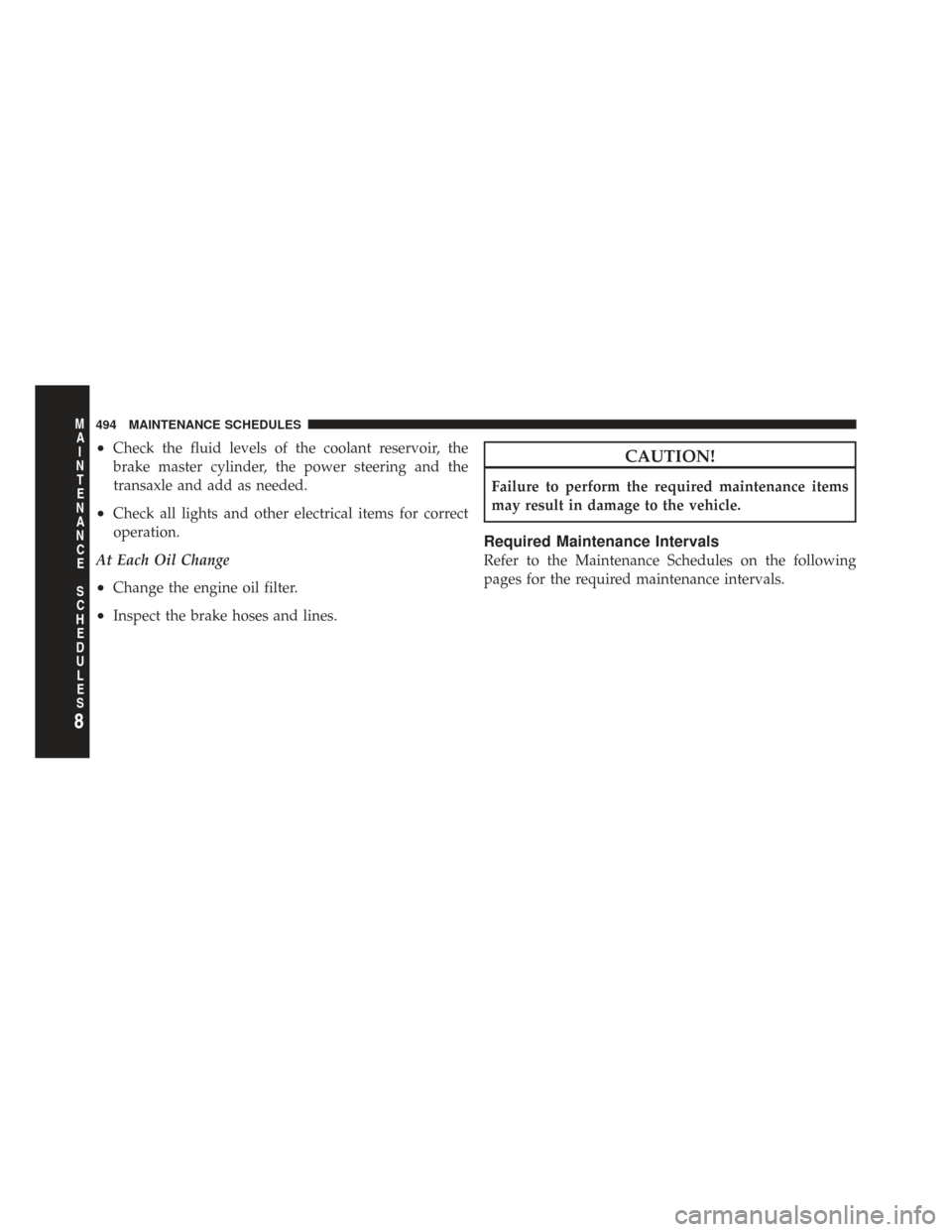
•Check the fluid levels of the coolant reservoir, the
brake master cylinder, the power steering and the
transaxle and add as needed.
•Check all lights and other electrical items for correct
operation.
At Each Oil Change
•Change the engine oil filter.
•Inspect the brake hoses and lines.
CAUTION!
Failure to perform the required maintenance items
may result in damage to the vehicle.
Required Maintenance Intervals
Refer to the Maintenance Schedules on the following
pages for the required maintenance intervals.
8
M A I
N T
E
N A
N CE
S
C
H E
D
U L
E
S494 MAINTENANCE SCHEDULES
Page 524 of 543
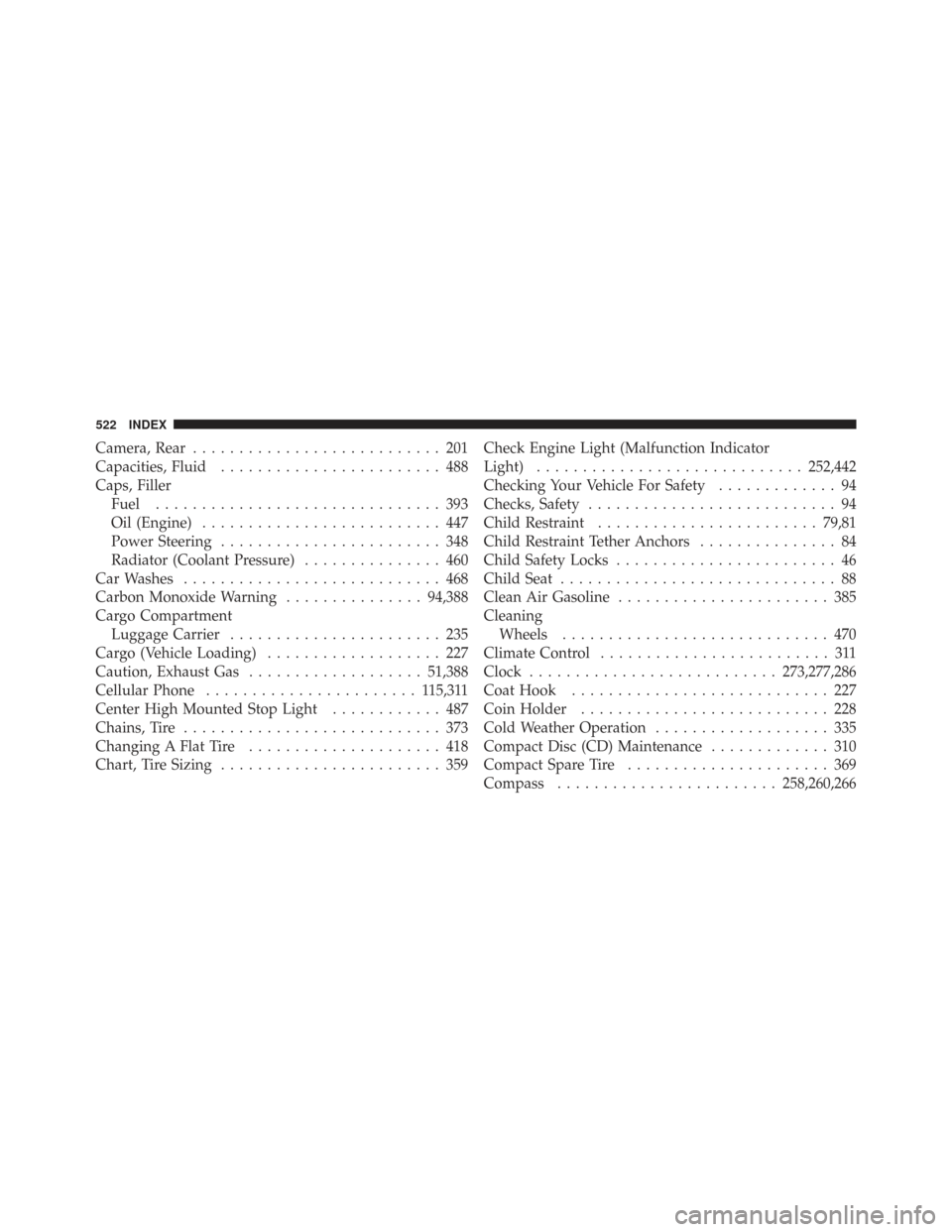
Camera, Rear........................... 201
Capacities, Fluid ........................ 488
Caps, Filler Fuel ............................... 393
Oil (Engine) .......................... 447
Power Steering ........................ 348
Radiator (Coolant Pressure) ............... 460
Car Washes ............................ 468
Carbon Monoxide Warning ...............94,388
Cargo Compartment Luggage Carrier ....................... 235
Cargo (Vehicle Loading) ................... 227
Caution, Exhaust Gas ................... 51,388
Cellular Phone ....................... 1 15,311
Center High Mounted Stop Light ............ 487
Chains, Tire ............................ 373
Changing A Flat Tire ..................... 418
Chart, Tire Sizing ........................ 359 Check Engine Light (Malfunction Indicator
Light)
............................. 252,442
Checking Your Vehicle For Safety ............. 94
Checks, Safety ........................... 94
Child Restraint ........................ 79,81
Child Restraint Tether Anchors ............... 84
Child Safety Locks ........................ 46
Child Seat .............................. 88
Clean Air Gasoline ....................... 385
Cleaning Wheels ............................. 470
Climate Control ......................... 311
Clock ........................... 273,277,286
Coat Hook ............................ 227
Coin Holder ........................... 228
Cold Weather Operation ................... 335
Compact Disc (CD) Maintenance ............. 310
Compact Spare Tire ...................... 369
Compass ........................ 258,260,266
522 INDEX
Page 526 of 543

Power Steering........................ 348
Disabled Vehicle Towing ................... 433
Disposal Antifreeze (Engine Coolant) ............... 460
Engine Oil ........................... 448
Domelight ............................. 180
Door Locks ............................. 30
Door Locks, Automatic .................... 33
Door Opener, Garage ..................... 207
Driving On Slippery Surfaces ................... 344
Through Flowing, Rising, or Shallow Standing
Water .............................. 345
DVD Player (Video Entertainment System™) .... 307
E-85 Fuel ............................. 389
Electric Remote Mirrors ................... 104
Electrical Power Outlets ................... 216
Electronic Brake Control System ............. 353Brake Assist System
.................... 354
Electronic Stability Program ............... 355
Electronic Speed Control (Cruise Control) ...... 193
Electronic Stability Program (ESP) ............ 355
Electronic Vehicle Information Center
(EVIC) ............................. 201,261
Emergency, In Case of Hazard Warning Flasher ................. 416
Jacking ........................... 418,420
Jump Starting ......................... 430
Overheating .......................... 416
Emission Control System Maintenance ......442,492
Engine ............................ 439,440
Air Cleaner .......................... 448
Block Heater ......................... 336
Break-In Recommendations ................ 93
Checking Oil Level ..................... 445
Compartment ...................... 439,440
Coolant (Antifreeze) .................... 489
524 INDEX